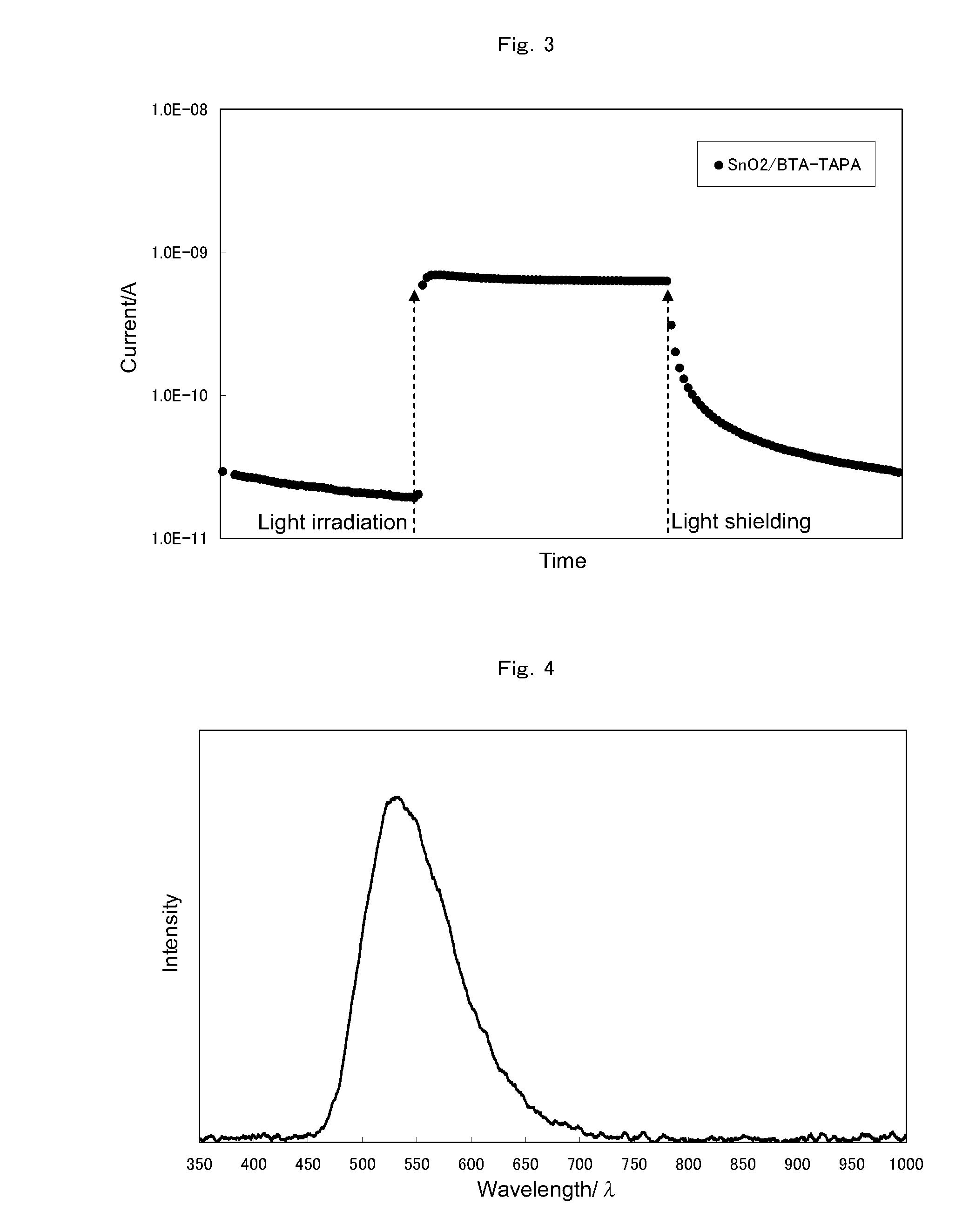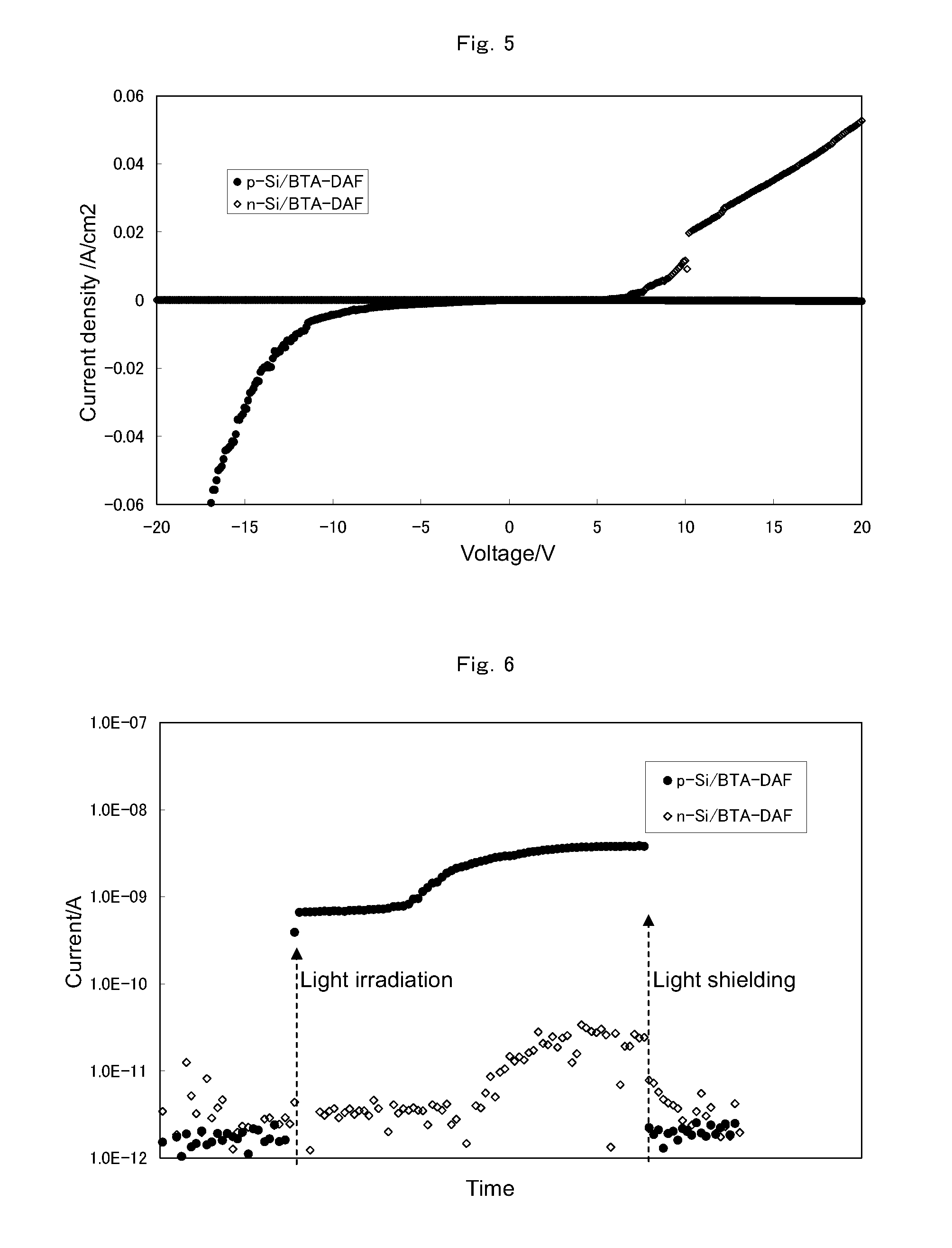Crosslinkable composition
a crosslinking composition and composition technology, applied in the field of crosslinking compositions, can solve the problems of low molecular weight compounds, require high-level molecular design, and cannot be formed in uniform laminated structures, etc., to achieve excellent conductivity, low resistance, and high conductivity
- Summary
- Abstract
- Description
- Claims
- Application Information
AI Technical Summary
Benefits of technology
Problems solved by technology
Method used
Image
Examples
example 1
(1) Preparation of Composition (Coating Composition)
[0264]In a 6-ml sample bottle, 16.2 mg of 1,3,5-triformylbenzene (manufactured by NARD INSTITUTE, LTD.) and 29.0 mg of tris(4-aminophenyl)amine were added, and these compounds were dissolved in 860 mg of N,N-dimethylacetamide. This mixture was filtered through a filter having a pore size of 0.2 μm to prepare a composition (a coating composition).
(2) Production of Organic Semiconductor Layer
[0265]The composition obtained in the step (1) was applied to a substrate by spin coating to produce a thin layer and then subjected to heat treatment at 300° C. for 1 hour under a nitrogen atmosphere to give an organic semiconductor layer (hereinafter, referred to as BTA-TAPA).
(3) Structure of Organic Semiconductor Layer
[0266](3-1) Solubility in Organic Solvent
[0267]A silicon wafer (or glass plate) was used as a substrate, and a BTA-TAPA layer was produced according to the method of the step (2). The resulting layer was insoluble in N,N-dimethyl...
example 2
(1) Preparation of Composition (Coating Composition)
[0276]In a 6-ml sample bottle, 16.2 mg of 1,3,5-triformylbenzene (manufactured by NARD INSTITUTE, LTD.) and 29.4 mg of 2,7-diaminofluorene were added, and these compounds were dissolved in 1400 mg of N,N-dimethylacetamide. This mixture was filtered through a filter having a pore size of 0.2 μm to prepare a composition (a coating composition).
(2) Production of Organic Semiconductor Layer
[0277]Using the composition obtained in the above step (1), an organic semiconductor layer (hereinafter, referred to as BTA-DAF) was obtained in the same manner as in Example 1.
(3) Structure of Organic Semiconductor Layer
[0278](3-1) Solubility in Organic Solvent
[0279]A BTA-DAF layer was produced in the same manner as in Example 1. The resulting layer was insoluble in N,N-dimethylacetamide and proved to have a three-dimensional network structure.
[0280](3-2) Band Gap
[0281]The UV-Vis spectrum of the BTA-DAF layer was measured in the same manner as in Ex...
example 3
(1) Preparation of Composition (Coating Composition)
[0286]In a 6-ml sample bottle, 16.2 mg of 1,3,5-triformylbenzene (manufactured by NARD INSTITUTE, LTD.) and 34.8 mg of 1,3-diaminopyrene were added, and these compounds were dissolved in 165 C mg of N,N-dimethylacetamide. This mixture was filtered through a filter having a pore size of 0.2 μm to prepare a composition (a coating composition).
(2) Production of Organic Semiconductor Layer
[0287]Using the composition obtained in the above step (1), an organic semiconductor layer (hereinafter, referred to as BTA-13DAPy) was obtained in the same manner as in Example 1.
(3) Structure of Organic Semiconductor Layer
[0288](3-1) Solubility in Organic Solvent
[0289]A BTA-13DAPy layer was produced in the same manner as in Example 1. The resulting layer was insoluble in N,N-dimethylacetamide and proved to have a three-dimensional network structure.
[0290](3-2) Band Gap
[0291]The UV-Vis spectrum of the BTA-13DAPy layer was measured in the same manner ...
PUM
| Property | Measurement | Unit |
|---|---|---|
| crosslinkable | aaaaa | aaaaa |
| aromatic | aaaaa | aaaaa |
| weight | aaaaa | aaaaa |
Abstract
Description
Claims
Application Information
 Login to View More
Login to View More - R&D
- Intellectual Property
- Life Sciences
- Materials
- Tech Scout
- Unparalleled Data Quality
- Higher Quality Content
- 60% Fewer Hallucinations
Browse by: Latest US Patents, China's latest patents, Technical Efficacy Thesaurus, Application Domain, Technology Topic, Popular Technical Reports.
© 2025 PatSnap. All rights reserved.Legal|Privacy policy|Modern Slavery Act Transparency Statement|Sitemap|About US| Contact US: help@patsnap.com



